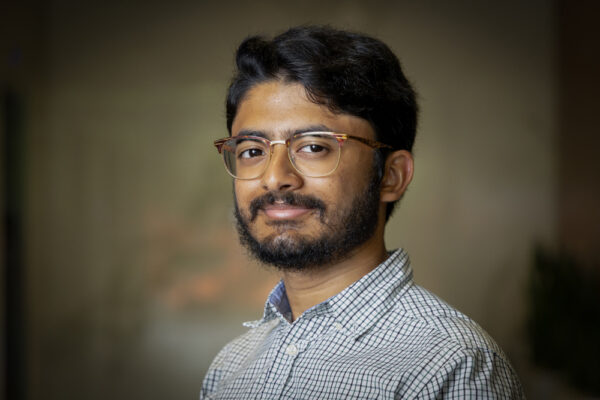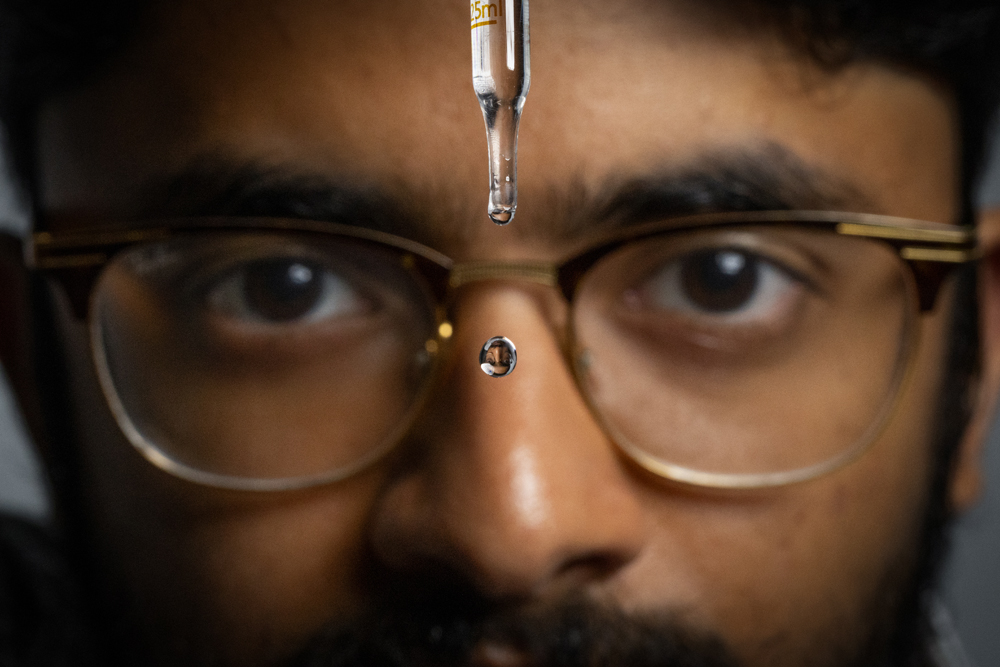Listen to the story:
Abel Abraham admits that he’s a fan of quiet. So, he didn’t mind being one of few students navigating UNC-Chapel Hill’s campus in September 2020.
“I’d attend my classes online and then walk to the lab every day after to work on my experiments,” he says. “It was a good reason to be on campus.”
As a first-year student during the pandemic, Abraham joined the Physical Mathematics Laboratory (PML) to stay in Chapel Hill instead of taking virtual classes from home. Through the PML, he immediately took a deep dive into research.
Carolina mathematician Pedro Sáenz directs the PML, which uses theory, simulations, and experiments to uncover new phenomena relevant to the fields of physics and engineering.
“The fact that we have labs in the math department at UNC is unique,” Sáenz says. “Most mathematicians work on pen and paper, but we have in-house experiments that you can compare your theories or simulations to and draw inspiration from. And Abel is an experimentalist.”
Now a senior at Carolina double-majoring in mathematics and biomedical engineering, Abraham has spent the last four years working in Sáenz’s lab. He developed his own experiments, spoke at conferences, and submitted his research for publication in a peer-reviewed journal.
And, alongside the lab’s other research, his project has the potential to radically change how we understand classical physics.
From watermelons to waves
When he started college, Abraham wanted to be a surgeon. When asked why, he laughs. His mom is a pediatrician and, one day, while watching him meticulously slice up a watermelon, she suggested it.
“I liked working with my hands,” he says, still chuckling. “Growing up in a small town in Kentucky, I didn’t have opportunities like Science Olympiad in school, but I liked cutting watermelon. And she noticed how patient I was and that I’d cut it systematically, removing the outside and cubing the rest.”
That attention to detail aided Abraham in the PML, where he studies walking droplets, or “walkers.” When added to a vibrating liquid bath, these droplets bounce repeatedly, self-propelling along the surface. Scientists observe that, even though the walkers are particles, they may behave like waves.
With Abraham’s help, Sáenz’s lab has discovered that these walkers can move chaotically when the floor of the bath is random, like any part of the ocean might be. During this process, the droplets mimic a phenomenon called Anderson localization (AL).
Imagine an ocean wave colliding with a dock and a pier. Upon impact, the structures break the wave’s pattern, causing it to diffuse and lose energy. When Anderson localization occurs, the wave maintains its energy for much longer, bouncing between the dock and the pier in an endlessly repetitive pattern. It’s like looping a song on Spotify.
AL was motivated by real-world observations. Physicist Philip Anderson theorized this phenomenon while investigating experiments that showed that metals filled with impurities can act as insulators. On a universal scale, this discovery was possible because quantum particles, like electrons, have a wave-like nature. Anderson won the Nobel Prize for this research in 1977.

Abel Abraham (photo by Alyssa LaFaro)
While AL has been shown to occur in subatomic systems, scientists believed it wasn’t possible with particles that can be seen with the human eye. In fact, Abraham’s project and the overall research of the Sáenz Lab challenges what scientists know about classical mechanics. These laws explain how large objects move — and they, typically, don’t move in a wave-like pattern. That’s what happens in quantum mechanics with tiny particles like electrons.
“We’ve been told all our lives that there are certain quantum effects, such as AL, that cannot be observed with macroscopic particles,” Sáenz says. “Abel demonstrated that his system exhibits particle localization analogous to what happens in quantum mechanics.”
This discovery was driven by curiosity more than application, according to Sáenz.
“We are inspired by the physicists of the 1920s, who pioneered the field of quantum mechanics,” he says. “Like them, we are primarily motivated to understand nature, and hope our work will lead to many advances, as theirs unquestionably has.”
This project could also increase our understanding of active matter, when a group of individuals work together to convert energy into motion. Classic examples of this include schools of fish and flocks of birds. It also has a variety of other potential applications.
“Being able to stop diffusion is useful,” Abraham says. “For example, when oil spills into the ocean, that creates a lot of droplets that we don’t want to spread. We want to clean them up. We want to be able to arrest diffusion.”
Failures and fixes
Abraham began working on this project in 2020, alongside lab members Frane Sazunic Antun Ljubetic and Stepan Malkov.
His first task involved creating a droplet generator for the experiment. He assembled the fluid chambers, nozzles, and tubing to eject the fluid alongside a circuit to control it. His laptop would power the device via a USB cable. The first time he hooked it all up to test it, he fried his USB port on his computer.
“It was pretty stupid,” he says, rolling his eyes. “There were more steps I should have taken before testing. But Pedro encouraged me and told me a story about melting a screwdriver at MIT. It was my first lesson that challenges and failures are part of every experiment.”
Abraham assessed every component of his creation to determine what went wrong. He eventually rebuilt a safer circuit, which would still routinely break while producing the droplets but without the risk of harming his computer. After a year of testing, he got it right.
“What I find most remarkable is that Abel did all of these things with minimal guidance” Sáenz says. “He is the kind of student who has a solution for a problem before the adviser knows that there is a problem.”
Once Abraham had a successful droplet generator, he shifted his focus to developing a 3D-printed model of random topographies, like a tiny mountain chain, to set on the bottom of the liquid bath to create a disordered environment for the walkers to bounce on.
Then, he spent the next year performing the experiments. By spring break of 2022, his results looked promising.
“We found that walking droplets in disordered environments don’t spread out over time, which is also how electrons and waves behave in similar environments,” Abel explains. “This is the first system where a macroscopic or large-scale particle localizes as a wave, like quantum particles do.”
As a result of the project, Abraham and his collaborators produced a paper that is currently under revision, and he has spoken about his work at professional conferences — a rare feat for an undergraduate student.
More than math
Whenever Abraham hit a roadblock in his experimental setup, he’d turn to other researchers in the lab for help, from graduate students to postdoctoral researchers. He believes that Sáenz has worked hard to create a collaborative environment that improves the overall success of the PML and the individuals within it.
“It’s a unique lab environment,” Abraham says. “We help each other out in any way that we can, and I learn a lot from them because they’re also doing research but in different stages of their careers. All of that contributed greatly to my research direction.”
While Abraham credits Sáenz for most of his successes in the department, Sáenz points to Abraham’s drive as the secret sauce behind his achievements.
“He is always prone to go the extra mile,” Sáenz says. “Typically with the students, I’m the one that has to set a high standard and push them a bit. With Abel, I didn’t have to do that. I’d set the standard — and he would meet it and even go farther.”
Abraham’s achievements within the math department make it easy to forget that he is a double-major, studying both mathematics and biomedical engineering. In addition to Sáenz’s lab, he works with professor William Polacheck, modeling fluids to study blood vessel function and smooth muscle cell movement.
During his sophomore year, he joined the design team of the Helping Hand Project — a student club that provides custom, 3D-printed prosthetics for children with limb differences — and eventually became president in 2023. He also modifies toys for children with disabilities through the nonprofit Carolina Adapts Toys for Children.
Most recently, Abraham received the math department’s 2024 Archibald Henderson Mathematics Medal, given annually to high-performing undergraduate students. After graduating this May, he will spend a year in Bangalore as a Fulbright scholar and then pursue his graduate degree at MIT, where he’ll work to understand the collective migration and organization of cells in tissue.
“All over nature, there’s complex and beautiful patterns,” he shares. “I hope to capture that beauty with the elegance of math and physics.”


